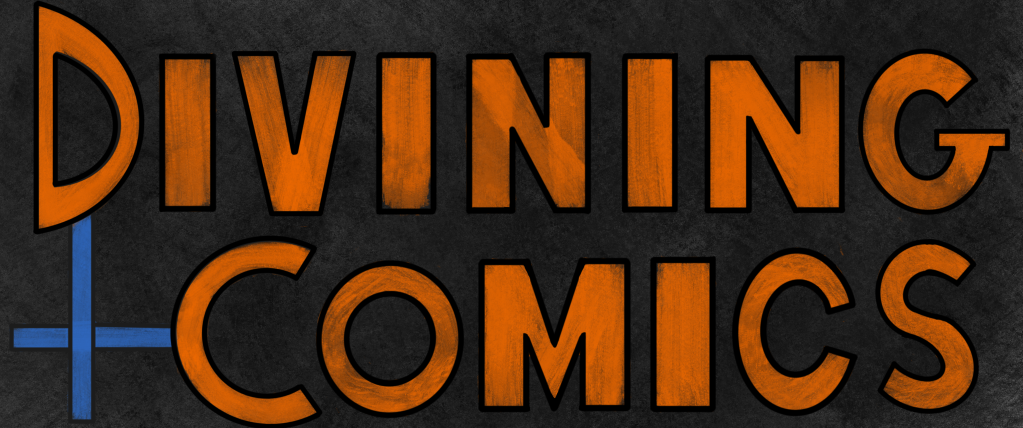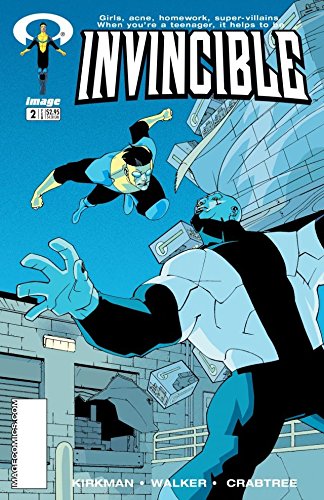Invincible # 2 and Crafting Satisfying Action through Setups and Payoffs
In Understanding Comics, Scott McCloud introduces the concept of closure, “the phenomenon of observing the parts but perceiving the whole“.1 Much of the magic of comics is built upon this one weird trick. When two images are placed in sequence, a reader interprets them as having some sort of relationship. Much can be skipped in between the two images, a yadda yadda yadda known in comics as the “gutter” between panels. If one image shows a couple kissing and the next shows the same couple holding a baby, you don’t have to see anything at all to know what likely happened in between.
Oftentimes, the relationship between images is simple cause and effect, action and reaction. Skilled magicians, knowing this mystery of the human brain, can intentionally manipulate it to tell a story. Invincible # 2, written and lettered by Robert Kirkman, drawn by Corey Walker, and colored by Bill Crabtree, uses this with aplomb in the fight scenes. Over and over again, they build anticipation in the moments before a clash, a setup, and then release it in a satisfying moment of violence, a payoff.
Let’s start with the basic and get more complex. A straightforward, logical progression can be useful for a comic because it doesn’t require much interpretation from the reader. It’s like a step-by-step instructional, or a flip-book. If everything in comics was told this simply, it would get boring fast. This is precisely because it doesn’t ask much of the reader. The magical flow of information doesn’t take any twists, turns, or shortcuts that impede the closure process. Now, just because it is simple doesn’t mean it is easy. Plenty of bad comics will miss a step, rendering the sequence confusing. It’s like a “learn how to dance” video that doesn’t break each step down enough. I can watch it over and over again, but I’ll never learn how to moonwalk.

In panel 1, Robot has a live wire. He attacks the Mauler twin with it in panel 2, and panel 3 shows the result of his attack. Setup, delivery, payoff. The joy you can get from a well-done sequence like this is akin to watching a well-choreographed sword fight, ballet, or John Wick scene. It culminates in the fourth panel, a well-drawn punch. Robot’s arm has followed through, and Mauler’s face is contorted by the impact. It gives a sense of completeness to the fight, a kicker to the setup/reaction of the previous three panels.
If you’re an aspiring artist, and you’ve mastered the simplest form of setup and payoff, you might be wondering how to progress. You don’t want to disappoint refined tastemakers like myself. I’ve already established that if comic books only stuck to that model, it would get boring quickly. Comics would be just for children, and I would be wasting my time writing about them is this much depth. Thankfully, that’s not the case.
The next level of complexity in crafting a fight scene is to reverse what is expected. Just when you think the pitcher has started their windup, they throw to first and catch the runner stealing. Or, in terms of this comic, the villain who is expected to get beat down actually lands the first punch. Look at these two panels here. In the first, Invincible is looming like Jason Momoa in that one meme, ready to pounce. On the next, Mauler plays the uno reverso card and sends Invincible reeling.


This isn’t only a great reversal that adds some tension and drama to the scene. It utilizes another technique in the comic mage’s spell book: the page turn. The first panel is the bottom part of one page, and the second panel is the top of the next. This heightens the element of surprise. But it also helps contribute to the closure in our minds. Turning a page in a comic book is an active process. Even when reading digitally, it requires the participation of the reader to swipe or tap over. By engaging the reader actively, the comic can get away with not actually showing how Mauler gets the upper hand here. It doesn’t show them winding up, and in fact, they have both arms occupied in the first panel. But, by making the reader turn the page, the comic plays a trick on our brains so that it fills in the missing step. That’s pretty remarkable!

There are other, similar twists to the setup and payoff structure. In this example, the payoff is interrupted and swapped out. Both Invincible and Mauler are squared up. No room for surprise hits here. But, instead of either of them attacking the other, an explosion sends them both backwards. Once again, the comic requires the reader to turn the page, this time in order to figure out who is responsible for this collatus interruptus. This delayed gratification makes the battle all the more enjoyable once it resumes.
Several of these techniques are combined together for the satisfying conclusion. The Mauler twin runs along the hypothetical z-axis, towards the reader, depicted by drawing him larger in panel three than in panel two. He looks ready to take on all of the heroes, scattered after the previous explosion. This still follows the setup/payoff structure, but adds to the build up by making the setup take two panels instead of the previous one. All of a sudden and out of nowhere, Invincible appears to take him down. The punch is satisfying and unexpected, but also serves to relieve the tension from Mauler’s extended windup. All of these pieces put in sequence, plus some other bits of dialog and banter, combine together to create a satisfying fight scene.

Go back and look at all of the pictures here. With the partial exception of Robot touching Mauler with the live wire, none of the action is actually shown directly. Exactly zero punches are drawn hitting jaws. What is drawn is the setup before the punch and the payoff afterwards. Our brains do the rest of the magic. And this technique can be applied in so many more ways besides fight scenes. When you are reading a comic, keep an eye out for setups and payoffs, because that will help you alongside your journey of Divining Comics.
- Page 64, because I always cite my sources ↩︎


Leave a comment